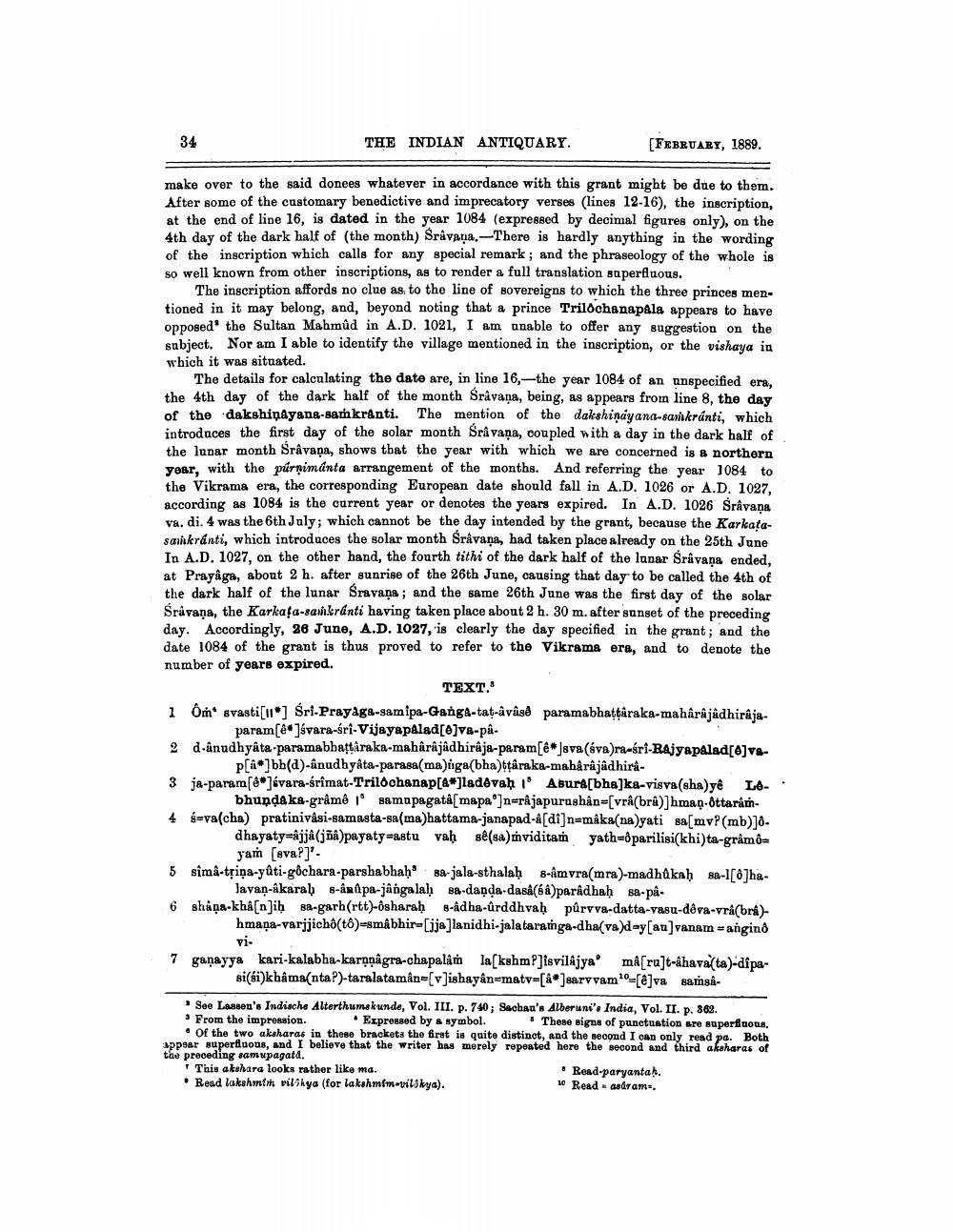________________
34
THE INDIAN ANTIQUARY.
[FEBRUARY, 1889.
make over to the said donees whatever in accordance with this grant might be due to them. After some of the customary benedictive and imprecatory verses (lines 12-16), the inscription, at the end of line 16, is dated in the year 1084 (expressed by decimal figures only), on the 4th day of the dark half of the month) Sråvara.-There is hardly anything in the wording of the inscription which calls for any special remark; and the phraseology of the whole is so well known from other inscriptions, as to render a full translation superfluous.
The inscription affords no clue as, to the line of sovereigns to which the three princes mentioned in it may belong, and, beyond noting that a prince Trilochanapala appears to have opposed' the Sultan Mahmûd in A.D. 1021, I am unable to offer any suggestion on the subject. Nor am I able to identify the village mentioned in the inscription, or the vishaya in which it was situated.
The details for calculating the date are, in line 16,—the year 1084 of an unspecified era, the 4th day of the dark half of the month Sråvana, being, as appears from line 8, the day of tho dakshinayang-sankranti. The mention of the dakshinayana-sanhkránti, which introduces the first day of the solar month Sravana, coupled with a day in the dark half of the lunar month Srâvaņa, shows that the year with which we are concerned is & northern year, with the purnimanta arrangement of the months. And referring the year 1084 to the Vikrama era, the corresponding European date should fall in A.D. 1026 or A.D. 1027, according as 1084 is the current year or denotes the years expired. In A.D. 1026 Sravana Va. di. 4 was the 6th July; which cannot be the day intended by the grant, because the Karkatasavikránti, which introduces the solar month Sravana, had taken place already on the 25th June In A.D. 1027, on the other hand, the fourth tithi of the dark half of the lunar Šrávaņa ended, at Prayaga, about 2 h. after sunrise of the 26th June, causing that day to be called the 4th of the dark half of the lunar Sravans; and the same 26th June was the first day of the solar Srávana, the Karkata-sankranti having taken place about 2 h. 30 m. after sunset of the preceding day. Accordingly, 26 June, A.D. 1027, 'is clearly the day specified in the grant; and the date 1084 of the grant is thus proved to refer to the Vikrama era, and to denote the number of years expired.
TEXT. i Ôm svasti(11) Sri-Prayage-samipa-Gang-tat-âvâsé paramabhattaraka-mahârâjâdhiraja
param[ee]śvara-sri-VijayapAlad[@]va-på2 danudhyâta-paramabhattaraka-mahârâjâdhirâja-param[e* Java (sva)ra-sri-Rajyapalad[6]ve
p[{"]bh(a)-anudhyâta-parasa(ma)iga(bha)ttâraka-maharajadhira3 A-paramsavara-srimat-Triloohanap[4*]ladevah Abura[bha]ka-visva(sha)vê LO
bhundaka-grâmê 1 samupagatâ mapa"]n=râjapurushån=[vrâ(brâ)]hman.Ottaram4 guva(cha) pratinivasi-samasta-sa(ma)hattama-janapad-4[di]n-maka(na)yati sa[mvP(mb)].
dhayaty=kjja (jña)payaty=astu vaḥ sé(sa)mviditam yath=8parilisi(khi)ta-grâmô
yam (sva?]'. 5 sima-třiņa-yûti-gôchara-parshabhah' sa-jala-sthalah B-Amvra(mra)-madhûkaḥ sa-1[6]ha
lavan-akarab s-ar apa-jângalah sa-danda-dasá(6)paradhah sa-pân. 6 shaņa-khá(njih sa-garh(rtt)-Osharaḥ 3-ad ha-ürddhvah purvva-datta-vasu-dôva-vra(bra).
hmaņa-varjjichô(t)=smábhir-[jja]lanidhi-jalataramga-dha(va)day[au]vanam-anging
7 ganayya kari-kalabha-kar några-chapalam la[kshm?]isvilajyam A[ru]t-hava(ta)-dipa
si(si)khâma(nta?)-taralatamân=[v]ishayânematy=[]sarvvam-[@]va samsk
Soo Lesson's Indische Alterthumskunde, Vol. III. p. 740; Sachaa's Alberuni', India, Vol. II. p. 862. • From the impression. Expressed by a symbol.
These signs of punctuation are superfluous, • of the two akaharas in these brackets the first is quite distinct, and the second I can only read pa. Both uppser superfluous, and I believe that the writer has merely repeated here the second and third akaharas of the preceding samupagatd. This akshara looks rather like ma.
. Read-paryantal. . Read lakshmirs pilskya (for lakshmim-vilikya).
10 Read ashrams.




